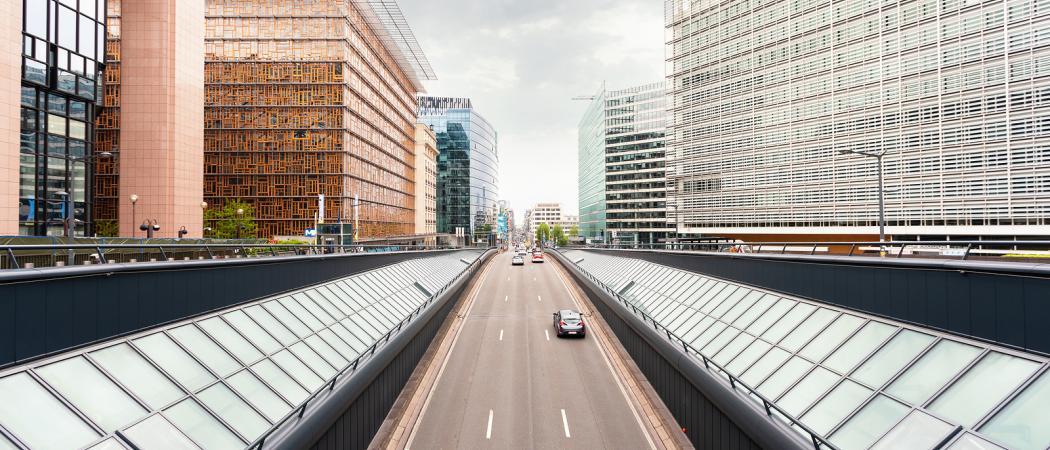The resumption of normal life is being attempted, but scientists warn that a new surge in infections can’t be ruled out

Lockdown measures have emptied the streets of Europe’s cities. Pictured above, Rue de la Loi in the EU district in Brussels. Photo: Bigstock
Something like pre-quarantine life is slowly returning to Europe, as countries seek to ease restrictions brought in to stem the spread of the deadly COVID-19.
But scientists say they are worried about what comes next. “Three months of COVID-19 have felt like three years,” said Giovanni Rezza, director of the department of infectious diseases at the Italian National Institute of Health in Rome.
In Italy, where almost 30,000 people have died in the pandemic, there isn’t the sense that the enemy has been defeated. “We are very worried about phase two. Another lockdown would be a disaster,” said Rezza.
The country’s re-opening is gradual and heavily monitored. “We have increased ICU [intensive care unit] places. But I’m worried about the winter – it will be really tough to deal with influenza and COVID-19 together,” he said.
The Italian lockdown, one of the strictest seen in Europe, saved many lives. “The south, where the health system is weaker, was not prepared. There were many healthcare workers without equipment. Having the experience of what happened, we’d have [gone about it all] in a lot cleverer way,” Rezza said.
Neighbouring Austria has fared a lot better with the disease. “We prepared for the worst. Now we have over-capacity; too much protective equipment; too many ICU places,” said Christoph Steininger, professor of internal medicine at the Medical University of Vienna. The country has recorded 600 deaths and 14,000 cases.
Next week, schools and restaurants will re-open. “Everything should be back by June,” said Steininger.
“The situation is well under control. We have few new cases. Any new cluster is contained, and checked. The re-opening of public life goes hand in hand with wearing masks and still keeping distance from each other. We hope we don’t see a big second surge – but I think we have to be prepared for a second wave, as soon as we fully re-open the gates.”
Social distancing of one metre will have to be sufficient, he said. “Two metres, or 1.5 metres, is impossible. It has to be practical,” he said. “You can’t keep people two metres apart on buses or trams.”
Denmark’s success
The lockdown has been slowly relaxing in Denmark for weeks, and faster than originally planned. The country has won praise for its swift action in restricting movement before Covid-19 infections were able to spread across the population.
“We handled the first phase extremely well,” said Christian Wejse, associate professor at the Department of Infectious Diseases at Aarhus University Hospital. “We had a complete shut down the exact same week as the first documented cases of local transmission, and this has proven to be very effective.”
The borders are closed and gatherings are limited to 10 people, but businesses are open again. “We had prepared for a massive intake of COVID-19 but it was only moderate, and it seems we have been able to keep the infection away from the most vulnerable and also have a very low in-hospital mortality,” said Wejse.
He’s not concerned about opening up again. “We have stayed on a falling epidemic curve and have not seen an increase in hospitalisations,” he said.
But he would prefer if the capacity to trace new cases was made a little stronger, to reduce the chances of a second surge in infections. “The country still has at least 1,000 infectious individuals in the country right now, who may set off a new wave of infections if we are not careful
“I have a slight concern that our tracking down of these cases is not effective enough, because that will be our best shot at getting down to zero if we can close the chains of transmission by testing all relevant contacts.”
Denmark has so far reported over 500 deaths and roughly 10,000 positive cases. There are health guidelines for the public to follow, but perhaps the government should be taking a stronger steer again, Wejse said. “The tracing is left for people to do on their own [via a contact tracing app], and I do not think that is sufficient, I think we should step up on that side and put it into the hands of professionals.”
Sweden’s controversial lockdown
Sweden has taken a light touch and has not imposed the kind of extraordinary lockdowns seen elsewhere, instead opting for an approach based on the “principle of responsibility”.
“I’m very curious about it. They don’t do much tracing, they don’t do much testing,” said Rezza. As to whether it has been a success, “The answer is yes, and no. If you compare it with France, Italy and Spain, it looks successful. But if you compare it with neighbours, and countries with similar cultures, then you have a horrific number of deaths,” said Umut Özkırımlı, visiting professor at the Barcelona Institute of International Studies.
Within Sweden, where there are 3,000 recorded COVID-19 deaths, the government’s approach is debated and contested. A group of 22 scientists last month wrote a damning letter, suggesting "officials without talent" had been put in charge of decision-making. The European Centre for Disease Prevention and Control warned this week that Sweden, along with Poland, Romania, Bulgaria and the UK, stood out as failing to reduce active coronavirus infections.
The death count in Sweden is unsettling, said Orla Vigsø, professor of communications at the University of Gothenburg. “I am concerned that there will be no mass testing followed by actions to contain the disease.”
“It’s incomprehensible that the country is lagging so badly on testing,” agrees Özkırımlı. “It is very much behind here.”
He describes the country’s approach as a “very Sweden-specific solution. If you’re told not to do something in Sweden, then you don’t do it. Swedes trust their experts, their politicians and each other. That’s their huge advantage, along with inherent assets like large physical distances between cities.”
There are fears in Poland about the population dropping its guard when the lockdown ends.
“The hotels and shopping centres are now opened, and kindergartens are allowed to welcome children again,” said Piotr Rzymski, a professor in the Department of Environmental Medicine at the Poznan University of Medical Sciences. But he’s concerned about a “dangerous relaxation in the sanitary regime”.
“People are supposed to use face masks in public spaces, but in many instances, they don't or they use them improperly; more and more often people don't care about keeping physical distance anymore, and I wouldn't be surprised if hand hygiene is also not as frequent as it was a few weeks ago,” he said.
“It is a worrying trend, as we didn't face a true COVID-19 peak in Poland, and further phases of reopening will promote a spread of the virus,” he predicts.
Germany tries to resume normal life
Chancellor Angela Merkel this week agreed to ease the coronavirus lockdown, saying the first phase of the pandemic had passed.
“Our huge ICU sector was reassuring – even at the height of infection, only 10 per cent of our capacity was occupied by COVID patients. Now, hospitals are as empty as they have ever been before,” said Reinhard Busse, head of the department of health care management at the Berlin University of Technology.
Germany has been held up as a model in dealing with the pandemic. The country has seen fewer than 7,000 deaths in the coronavirus pandemic – a much lower figure than in other western European countries including the UK, Italy, France and Spain.
“Testing helps to explain our figures – we started early, much earlier [than other countries],” Busse said. Health officials were already, in February, tracing and isolating suspected cases. “We were prepared then for when things exploded in March,” said Busse.
German GPs were given test kits early, meaning the majority of COVID-19 cases didn’t even make it to the hospital. “Only one in seven COVID patients had any contact with a hospital,” said Busse.
The UK government has cautioned that it is too soon to make any comparison on COVID-19 death rates but Busse disagrees.
“If you disentangle the date, so you’re measuring the same things, you can compare. That should not prevent us from doing comparisons or it should not be an excuse,” Busse said.
Still, everywhere there is an underestimation of COVID-19 deaths, said Rezza. “There’s the people who died in their homes, for example, who probably have not been counted in many places yet,” he said. The full accounting will take a while.





 A unique international forum for public research organisations and companies to connect their external engagement with strategic interests around their R&D system.
A unique international forum for public research organisations and companies to connect their external engagement with strategic interests around their R&D system.